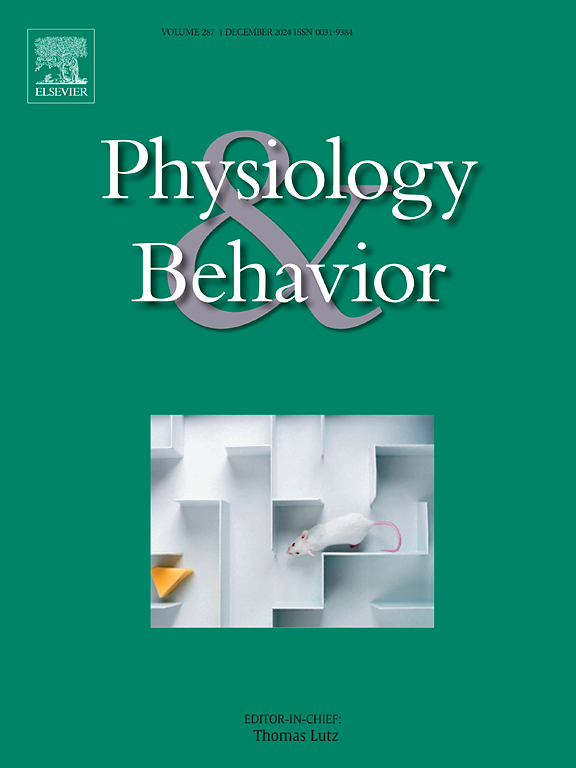慢病毒介导的miR-124通过抑制雄性和雌性大鼠伏隔核中的BDNF调节甲基苯丙胺奖励。
IF 2.5
3区 医学
Q2 BEHAVIORAL SCIENCES
引用次数: 0
摘要
MicroRNAs (miRNAs)是基因表达的关键调控因子,与情绪障碍和成瘾的病理生理有关。其中,已知miR-124调节突触可塑性和神经元功能,但其在甲基苯丙胺(METH)奖励中的具体作用仍知之甚少。本研究旨在探讨miR-124及其下游靶点脑源性神经营养因子(BDNF)在伏隔核(NAcc)中介导甲基安非他明诱导的条件位置偏好(CPP)中的作用。通过结合行为分析、RT-PCR和慢病毒介导的基因操作,我们检测了miR-124的功能获得和功能丧失,以及BDNF的过表达对雄性和雌性大鼠METH-CPP的影响。甲基苯丙胺治疗在两性中引起了强烈的CPP,没有显著的性别差异。RT-PCR分析显示,甲基安非他明暴露增加了miR-124的表达,同时降低了NAcc中BDNF mRNA的水平,两者之间呈强负相关。miR-124敲低降低了METH-CPP,增加了BDNF表达,逆转了负相关,而miR-124过表达增强了CPP,降低了BDNF,并增强了相关性。重要的是,BDNF在NAcc中的过表达降低了METH-CPP,模拟了miR-124敲低的作用。这些发现表明,miR-124通过抑制NAcc中的BDNF表达来增强甲基苯丙胺奖励,突出了成瘾中的关键miR-124/BDNF调节轴。这项研究为甲基安非他明奖励的分子机制提供了新的见解,并强调了miR-124/BDNF轴作为一种途径,可能值得在物质使用障碍的背景下进一步研究。本文章由计算机程序翻译,如有差异,请以英文原文为准。
Lentiviral-mediated modulation of miR-124 regulates methamphetamine reward through BDNF suppression in the nucleus accumbens of male and female rats
MicroRNAs (miRNAs) are critical regulators of gene expression and have been implicated in the pathophysiology of mood disorders and addiction. Among these, miR-124 is known to modulate synaptic plasticity and neuronal function, yet its specific role in methamphetamine (METH) reward remains poorly understood. This study aimed to investigate the role of miR-124 and its downstream target, brain-derived neurotrophic factor (BDNF), in the nucleus accumbens (NAcc) in mediating METH-induced conditioned place preference (CPP). Using a combination of behavioral assays, RT-PCR, and lentiviral-mediated gene manipulation, we examined the effects of miR-124 gain- and loss-of-function, as well as BDNF overexpression, on METH![]() CPP in male and female rats. METH treatment elicited robust CPP in both sexes, with no significant sex differences. RT-PCR analysis revealed that METH exposure increased miR-124 expression while decreasing BDNF mRNA levels in the NAcc, with a strong negative correlation between the two. miR-124 knockdown reduced METH
CPP in male and female rats. METH treatment elicited robust CPP in both sexes, with no significant sex differences. RT-PCR analysis revealed that METH exposure increased miR-124 expression while decreasing BDNF mRNA levels in the NAcc, with a strong negative correlation between the two. miR-124 knockdown reduced METH![]() CPP, increased BDNF expression, and reversed the negative correlation, whereas miR-124 overexpression enhanced CPP, decreased BDNF, and reinforced the correlation. Importantly, BDNF overexpression in the NAcc reduced METH
CPP, increased BDNF expression, and reversed the negative correlation, whereas miR-124 overexpression enhanced CPP, decreased BDNF, and reinforced the correlation. Importantly, BDNF overexpression in the NAcc reduced METH![]() CPP, mimicking the effects of miR-124 knockdown. These findings demonstrate that miR-124 enhances METH reward by suppressing BDNF expression in the NAcc, highlighting a critical miR-124/BDNF regulatory axis in addiction. This study provides novel insights into the molecular mechanisms underlying METH reward and highlights the miR-124/BDNF axis as a pathway that may warrant further investigation in the context of substance use disorders.
CPP, mimicking the effects of miR-124 knockdown. These findings demonstrate that miR-124 enhances METH reward by suppressing BDNF expression in the NAcc, highlighting a critical miR-124/BDNF regulatory axis in addiction. This study provides novel insights into the molecular mechanisms underlying METH reward and highlights the miR-124/BDNF axis as a pathway that may warrant further investigation in the context of substance use disorders.
求助全文
通过发布文献求助,成功后即可免费获取论文全文。
去求助
来源期刊

Physiology & Behavior
医学-行为科学
CiteScore
5.70
自引率
3.40%
发文量
274
审稿时长
47 days
期刊介绍:
Physiology & Behavior is aimed at the causal physiological mechanisms of behavior and its modulation by environmental factors. The journal invites original reports in the broad area of behavioral and cognitive neuroscience, in which at least one variable is physiological and the primary emphasis and theoretical context are behavioral. The range of subjects includes behavioral neuroendocrinology, psychoneuroimmunology, learning and memory, ingestion, social behavior, and studies related to the mechanisms of psychopathology. Contemporary reviews and theoretical articles are welcomed and the Editors invite such proposals from interested authors.
 求助内容:
求助内容: 应助结果提醒方式:
应助结果提醒方式:


